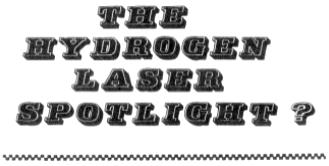found a couple of flash tubes, some gas
coils that still worked, and an optical pump, and he was
off and running. Within a week that first model was able
to illuminate a picnic area in Runnamuck State Park all
the way from Hellmouth, with only two small brush fires
as an unfortunate side effect. It was clear to all of
us, especially to me, that Dad, Sir Horton, was on the
track of something. Later, he got the Nobel Prize
for finding a black hole in the Newark, N.J. Bulk Mail
Center. When he died as a result of being burned
severely by the spotlight, it was put up for auction and
sold to some Japanese businessmen, but they couldn't make
the payments so I was able to get it back. Now,
years later, we have almost worked out all the bugs, and
the little problems that continue to nag us, the minor
scrapes and pinched fingers, the tendency of the spotlight
to swing around without warning and burn people severely,
and so on, are more of a nuisance than anything else.
Many people have asked
me as they see me wheeling the heavy spotlight around
the Nooz offices just how it works. To put
it simply, the operation of the hydrogen laser spotlight
is based on the fundamental theory of themolecule. Every
molecule in the universe is pretty much like a warehouse
of energy, with rows and rows and rows and rows of atoms
stacked all the way up to the ceiling. But when
you try to pack too many atoms too close together, they
get all excited and start glowing, and this is how laser
light is produced. The extreme power of the hydrogen
laser spotlight enables it to illuminate vast areas in
distant countries or focus on the tiniest pinhead. The
Nooz stays in constant contact with the fire departments
of the countries which the spotlight is aimed at, just
to be on the safe side.
At the moment, the
hydrogen laser spotlight is being refurbished at Hellmouth
Small Appliance Repair and having a few modifications
done. The technician there has promised that it
will be ready in about a month. Some thirty days
from now, the atmosphere will be in a good position to
align the spotlight on the scarred, eroded, ecologically
ravaged and ruined countrside of Madagascar, and we very
much hope to be able to take advantage of this rare, only
eight times a year happening. |

